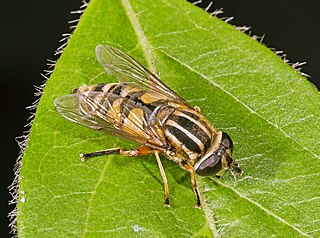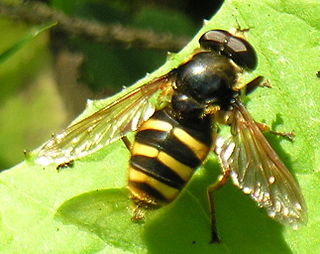
Eristalinus is a genus of hoverfly. Most species have very distinctive eye marking in the form of spots or banding, though these features may fade on some preserved specimens. Most are stout flies, and are nimble flyers, even compared to other hoverfly species.

Helophilus are a diverse genus of moderate to large hoverflies, that appear somewhat bee-like. Larvae filter-feed in organic rich water. All Helophilus adults have a distinctive lengthwise striped thorax and a transverse striped abdomen.

Myolepta is a cosmopolitan genus of hoverflies most closely related to the genus Lepidomyia

These are small black and yellow or mostly black flies with a narrow abdomen near the thorax. They occur mainly in damp places among low herbage. The larva of Neosascia are flattened without oral hooks and a have a short posterior spiracular process or "tail" rat-tailed that is saprophagous. In 1925 Curran reviewed the genus Neoascia. In this work a key is provided and ten species are described including four new species some of which have later been determined to be synonyms.

Orthonevra is a genus of fly in the syrphidae family with at least 59 species identified so far. They are worldwide in distribution but concentrated in the Eastern North America and Europe.Orthonevra are commonly called Mucksuckers after the larvae which have been found in organic rich mud, i.e. muck. This genus belongs to the tribe Brachyopini that includes the prominent genera Melanogaster, Brachyopa, Neoascia and Sphegina. Orthonevra have black heads with blue to purple reflections. Many species have distinctive eye stripes. The antennae are somewhat elongate. The frons is wrinkled with silvery spots at sides of antennae. The thorax with small punctures dorsally and in several species the body is covered with scale-like pile. Wingd vein M1 curves away from the wing tip.(see images)

Sercomyia are large flies with species that are bee mimics both short pile and long pile. Sericomyiine flower flies are common in boreal forests across the Holarctic region and southward at higher elevations into the Oriental and Neotropical regions. Sericomyia species have larvae of the rat-tailed maggot type, often found in ponds rich in decomposing vegetation where they filter out microorganisms as their food
Sphegina aterrima is a species of hoverfly in the family Syrphidae.
Sphegina claviventris is a species of hoverfly in the family Syrphidae.
Sphegina obscurifacies is a species of hoverfly in the family Syrphidae.
Sphegina spiniventris is a species of hoverfly in the family Syrphidae.
Sphegina nitidifrons is a species of hoverfly in the family Syrphidae.
Sphegina dogieli is a species of hoverfly in the family Syrphidae.
Sphegina grunini is a species of hoverfly in the family Syrphidae.
Sphegina melancholica is a species of hoverfly in the family Syrphidae.
Sphegina hodosa is a species of hoverfly in the family Syrphidae.
Sphegina smirnovi is a species of hoverfly in the family Syrphidae.
Brachyopa maritima is an Asian species of hoverfly.
Brachyopa paradoxa is an Asian species of hoverfly.
Brachyopa pivanica is an Asian species of hoverfly.
Brachyopa stackelbergi is an Asian species of hoverfly.





